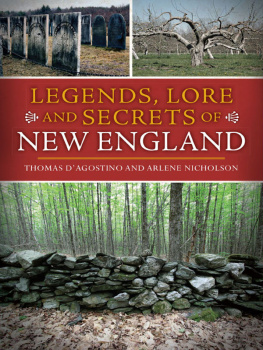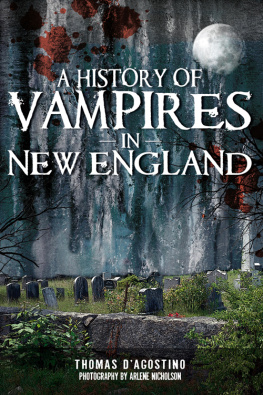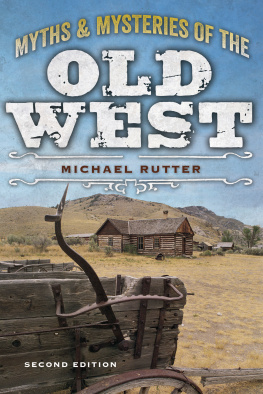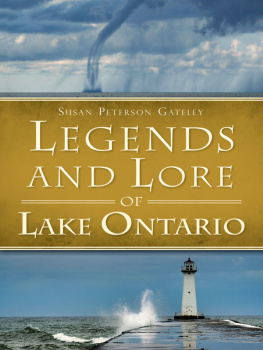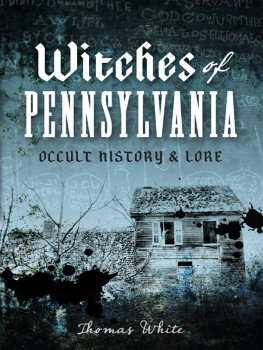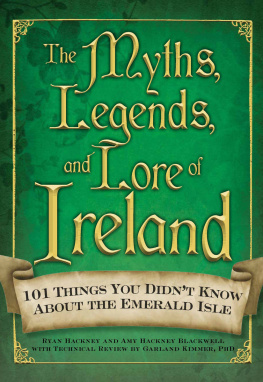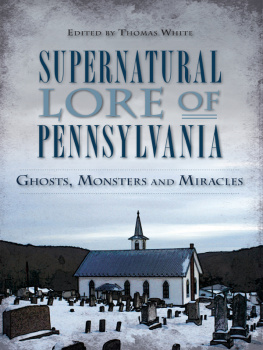
Published by The History Press
Charleston, SC 29403
www.historypress.net
Copyright 2013 by Thomas DAgostino and Arlene Nicholson
All rights reserved
Front bottom cover photo by Eric Charles Steinhart.
Photos by Arlene Nicholson unless otherwise noted.
First published 2013
e-book edition 2013
Manufactured in the United States
ISBN 978.1.61423.979.6
Library of Congress CIP data applied for.
print edition ISBN 978.1.60949.946.4
Notice: The information in this book is true and complete to the best of our knowledge. It is offered without guarantee on the part of the authors or The History Press. The authors and The History Press disclaim all liability in connection with the use of this book.
All rights reserved. No part of this book may be reproduced or transmitted in any form whatsoever without prior written permission from the publisher except in the case of brief quotations embodied in critical articles and reviews.
This book is dedicated to all.
You never know who will become a legend for future generations to admire.
CONTENTS
ACKNOWLEDGEMENTS
As usual, there are so many people who have made this book possible. We are grateful to all for your assistance and expertise. Grateful thanks and praise go out to the Burrillville Historical Society; Rutland Historical Society; Sams Good News in Rutland; Putnam Public Library; Greenville Public Library; Foster Town Hall; Scituate Town Hall; everyone at the Kennebunk Inn; Ron Kolek; Ron Kolek Jr.; Christopher Balzano and Massachusetts Crossroads; Matthew Moniz of Spooky South Coast; Brian Harnois; Jason Mayoh; Christian White; Kent Spottswood; Sheila and Beth Williams; Skip Gervais at the Mill in Greenville; the good people of Portsmouth, New Hampshire; Jeff Saraceno; Carl Johnson; Blackstone Valley Tourism Council / Tour Southern New England; Tom and Sue Wood; Greg and Magin Wood; Patti Roden; Kevin Fay; High Life Ski Lodge; Hampton Historical Society; Princeton Historical Society; Mulligans in Biddeford; Mandy Pincins; Webster Library; the Patriot newspaper; the Yankee Shopper; Tavern on Main; Smiths Castle; Barbara Thaeder; and all those who wished to remain anonymous but were vital in the making of this book.
INTRODUCTION
New England is a magical land where the boundaries of time and timelessness create a seam of our existence that is often stranger than fiction. The antiquity of the region is ripe for legends and stories that, if not for documentation, would certainly be thought the work of some far-out writer or storyteller. Within the pages of this book are the legends and the actual facts that somehow took a back burner to more potent storylines that would become the accepted views of what transpired. Lucy Keyes, Hannah Frank, John Burke, Hannah Robinson, William Blackstone and many more hold special places in our history and should be addressed with as much accuracy as time and archaic writings will allow. This also goes for the places that have made New England a special region worth exploring.
The characters and places you are about to acquaint yourself with may seem too far-fetched to be true in some cases, but be assured that these pieces of history have much more than a thread of truth running through them. In some cases, you will read anecdotes of historical phrases or terms that have either passed from generation to generation without the knowledge of their origin or have been modified and twisted into slang to fit the day. In other cases, there is much more behind some of the timeworn legends we have come to accept.
This compendium has no time frame. It covers some of our favorite events, places and people throughout the region. These accounts have a beginning, and at some point in time, someone was the first to pen them for historys sake. Painstaking efforts to find those first writings have resulted in more than their share of conflicting accounts for some of the legends within this book. Others have been compiled from several sources to be collected into a single work for the first time. Some of these stories of legends and lore are hundreds of years old, while others have yet to become perennial tales to be told on cold nights when the New England wind whistles about the windows and the shadows grow long with the ever-dimming light.
LUCY KEYES
The Lost Child of Wachusett
As the sun begins to descend within the shadow of Wachusett Mountain, a voice is heard echoing in the wind. Rather soft at first, the reverberations grow louder with each beckoning until the now attentive listener can easily recognize the moan, Lucy! Luuucyyyy!
It is not the scream of a banshee but rather a mothers desperate plea for one little girl to come home, a little girl who has been lost for centuries. Her mother, Martha Keyes, has also long passed and is but dust in the grave. Yet her spirit roams in the twilight hours, eternally searching for her lost daughter, four-year-old Lucy Keyes, who disappeared more than two and a half centuries ago.
Robert Keyes (September 21, 1711March 1, 1795) married Martha Bowker on December 24, 1740. Together, they had ten children. In 1751, Robert and Martha Keyes bought two hundred acres of land from Benjamin Muzzey and settled on the southeastern slope of Wachusett Mountain in Princeton, Massachusetts. Princeton was incorporated in 1759, so the land was sparsely settled; their closest neighbor, legend says, was a recluse named Tilly Littlejohn.
Shortly after moving to Princeton, Martha gave birth to Lucy. The little girl had the eyes of her father and the beauty of her mother. On April 14, 1755, Martha sent her two older daughtersPatty, age seven, and Anna, age nineto Wachusett Pond to fetch some white sand for the purpose of making a polishing agent for their pewter. It was common practice to also spread the sand on the floor around the stove or working area to soak up any grease or fat from the meat while it was being prepared. It also served to keep any embers or stray sparks from igniting the wooden floors. Lucy somehow managed to follow her sisters to the lake, where they immediately told her to turn around and get home or mother would be very upset.
Before long, the two girls returned from their task and inquired as to Lucys whereabouts. Being so preoccupied with her chores, the mother had not seen Lucy slip away out the door and down the trail toward the pond with the two girls. Little Lucy apparently never made it back to the home.
Martha rushed frantically out into the wild of the mountain, screaming Lucys name. Some folks nearby heard the clamor and summoned Robert Keyes, who quickly formed a search party in the hopes of finding the young girl as the day slivered its last shards of light over the countryside. The only evidence attesting to where Lucy may have wandered were a few broken twigs at the end of the trail.
For several days, neighbors searched the mountainside for Lucy, but to no avail. Those who helped in the search felt despair for Robert and Martha Keyes, and those who lived in the distance heard, for days, one desperate cry echo over the mountain: Lucy! Luuuucyyy!
In time, the search was called off, for it was certain that Indians or one of the wild animals of the mountain had taken young Lucy. Robert Keyes inquired with the nearby tribes as to any sign they may have seen of his daughter, but none had seen hide or hair of her. Martha, in what some claim was despondency and others madness, continued to roam the woods every night, calling Lucys name in the hopes that her little girl might return to her. For the next thirty-one years, her voice would resonate through the hillside calling for her lost child.
Next page
